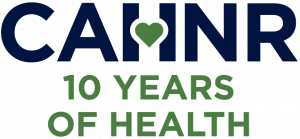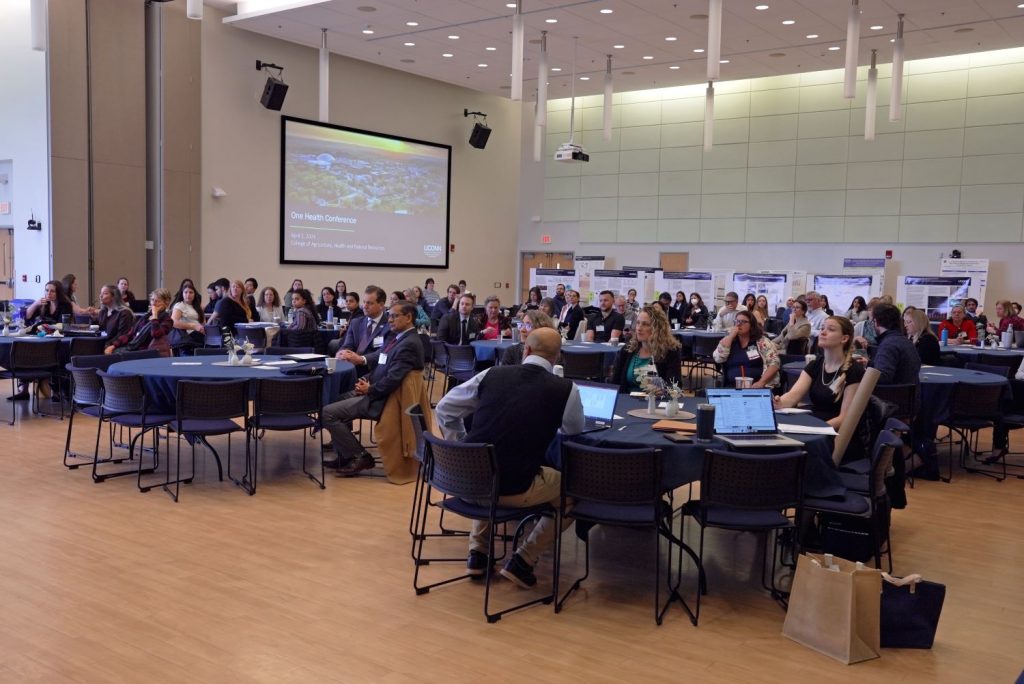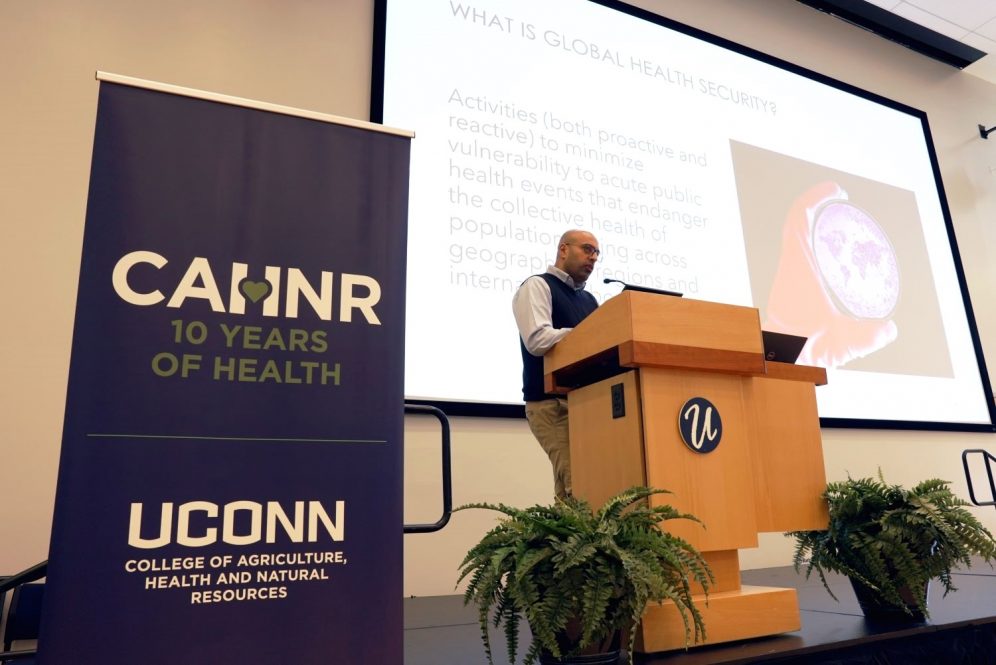Most people are startled to realize that animals can spread 60% of all infectious diseases in humans. The last few years have accentuated the fact that human and animal health are intricately impacted by plants and the environment too. Humans further encroach on wildlife habits as our population increases. We also keep animals as pets, livestock, or for sport, and all these interactions can increase incidences of zoonotic diseases that spread between humans and animals. The ease of international travel also increases disease spread.  Climate change and deforestation are another environmental area where we see negative health impacts because loss of habitat and the beneficial services that trees and plants provide can again increase the spread of disease.
Climate change and deforestation are another environmental area where we see negative health impacts because loss of habitat and the beneficial services that trees and plants provide can again increase the spread of disease.
The One Health concept seeks to improve health outcomes using interdisciplinary approaches that recognize how people, plants, and animals share the environment, according to the Centers for Disease Control and Prevention (CDC).
“Ensuring a healthy people through a healthy planet is also one of UConn’s priority areas. We’re working together to ensure a sustainable future in all aspects of our world – from climate change to food security and global health,” says Indrajeet Chaubey, dean of UConn’s College of Agriculture, Health and Natural Resources (CAHNR). “CAHNR is uniquely positioned to make a positive impact on One Health with our broad range of disciplines in the areas of human, animal, plant, and environmental health.”
One Health at UConn
CAHNR hosted a One Health conference on April 1, 2024, with over 140 attendees to further promote the interdisciplinary and integrative approach to worldwide health. The conference featured keynote speakers and world cafe working sessions where attendees discussed One Health concepts, including three frameworks, and potential solutions and initiatives that CAHNR can facilitate. Attendees reviewed CAHNR’s progress and helped create action towards the next steps in the One Health realm. Each framework (equity from the global to local level, the human-animal-environmental interface, and the changing ecosystem) had an overview and interactive session where attendees identified solutions and pathways towards solutions.

Undergraduate and graduate students presented posters documenting their efforts in One Health as well.
“The One Health Conference was part of a major strategy led by CAHNR to include One Health at the center of our research, extension, and education at UConn,” says Elsio Wunder, assistant professor in pathobiology and veterinary sciences. “We are trying to learn and follow the ways that native civilizations approached and maintained a healthy balance on this amazing interface between humans, animals, plants, and environment, while also adapting to the new challenges that we will inevitably face in the future.”
Additionally, CAHNR offers an undergraduate course, One Health: People, Animals, Plants, and the Environment that introduces students to a diverse range of One Health topics. The course is in its second year and fulfills an environmental literacy general education requirement.
“Students are interested in the course because of its implications on their lives and careers, recognizing the need for different and more sustainable approaches to the grand challenges we’re facing,” says Kristen Govoni, CAHNR associate dean of academic programs. “The course easily fills each semester.
Another undergraduate course, also offered by the Department of Pathobiology and Veterinary Science, is a two-semester series on Systems Pathophysiology.
The courses study diseases using the systems approach at both the gross and microscopic levels.
A One Health minor is being developed and soon will be open to students from all majors throughout UConn. Other student opportunities include research projects, a One Health student club, internships, and experiential learning. Much of CAHNR’s research aligns with this One Health initiative from both the prevention and adaptation standpoints.
Prevention and Adaptation as Part of One Health
In the prevention realm, researchers in the Department of Animal Science have a provisional patent to spray eggs with probiotics as a health and growth enhancement instead of using antibiotics. Food safety is another key area of One Health, especially when considering outbreaks like Salmonella. Another research project is looking at protective bacteria to address antibiotic resistant Salmonella in food. UConn Extension professionals provide food safety training and educational outreach to change behavior and practices, while also increasing awareness of the food safety risks.
Prevention through vaccination remains one of the public’s best tools, and researchers in the Department of Pathobiology and Veterinary Science are working on vaccines for several globally significant infectious diseases. Simultaneously, their colleagues at the Connecticut Veterinary Medical Diagnostic Laboratory (CVMDL) are monitoring diseases and working closely with regulatory officials to report any incidences. This dual approach ensure adequate response.
Adaptation is another key component of CAHNR’s One Health initiatives. Human health is highly individualized and impacted by many factors. Research on heat exertion, along with adaptation and mitigation strategies at the Korey Stringer Institute, a center within the Department of Kinesiology, is helping humans confronted by a changing climate.
Other elements of individualized health like diet, exercise, and mental health. Different research, teaching, extension, and service programs from throughout the College address these unique aspects of human health. Researchers in the Department of Allied Health Sciences are looking at exercise and activity levels to improve healthful outcomes in older adults. Professionals in this department and the Department of Nutritional Sciences are providing nutrition education programs that lead to lasting changes. Physical therapists in Kinesiology are also being trained with the Mental Health First Aid Kit to better assist their patients.
Soil health is an important component of environmental health, and an interdisciplinary team of researchers from the Departments of Natural Resources and the Environment and Plant Science and Landscape Architecture are studying cover crop impacts on soil microbial properties. This ties into greenhouse gas emissions from the soil and is influenced by climate conditions as well. Adjustments in planting dates, cover crop type, and seeding rates could improve soil health.
Waste management is a challenge for municipalities throughout Connecticut and can negatively impact health. Research in the Department of Agricultural and Resource Economics helps municipalities determine environmentally and economically-friendly strategies for waste management with sustainability as a key premise.
Globally, One Health is widely adopted, and many are using it to strengthen collaborations and develop synergistic solutions for zoonotic diseases, climate change, and environmental degradation. Faculty, staff, and students throughout CAHNR are working together on this multi-faceted One Health approach and providing solutions for a more sustainable future.
CAHNR’s One Health initiative relates to all five Strategic Vision areas and is a sub-committee of the Health and Well-being SVIC.



